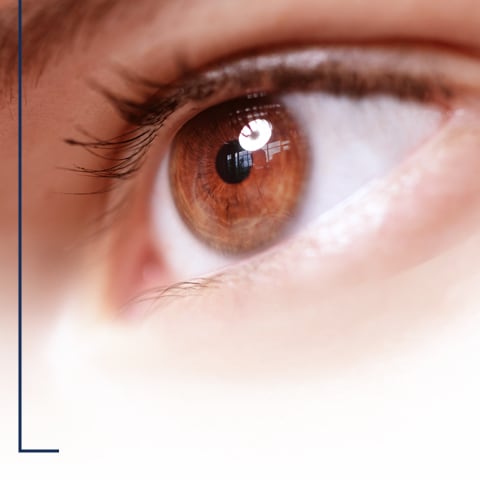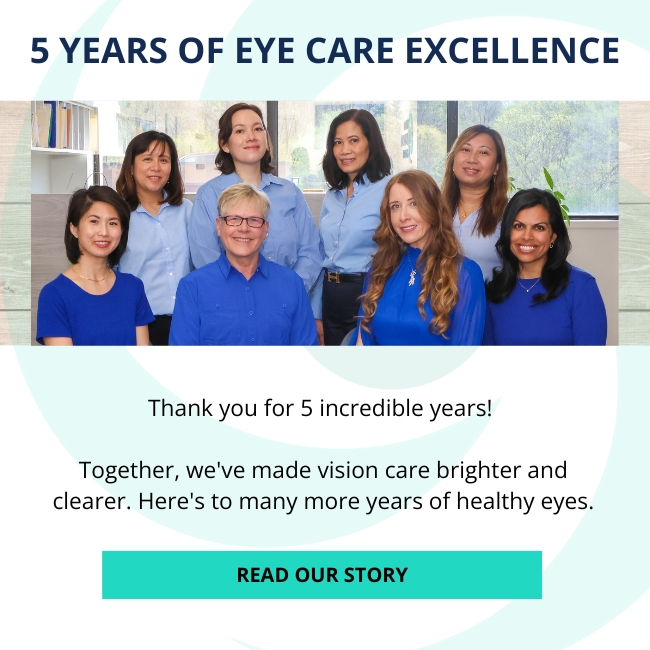If you’ve ever heard of red light therapy in a dermatology setting, you know it has been making waves for years in skin care. Dermatologists have used specific wavelengths of red and near-infrared light to help with collagen production, wound healing, and reducing inflammation. But now, the same principles that have been improving skin are being investigated for their potential to support eye health – a field known as low-level light therapy or photobiomodulation (PBM). Research into PBM for ocular conditions is still evolving, but the early results are promising, especially for age-related macular degeneration (AMD), glaucoma, and dry eye disease.
What is Low-Level Light Therapy / Photobiomodulation?
Low-level light therapy uses non-invasive, non-thermal light in the red to near-infrared range (generally 600–1,000 nm wavelengths). These wavelengths penetrate tissue and are absorbed by the mitochondria (i.e. our cells’ “powerhouses”). This absorption can enhance mitochondrial function, leading to increased energy production (ATP) and reduced oxidative stress.
In the context of eye health, this is important because many ocular diseases involve oxidative damage and reduced cellular energy, whether in the retina, optic nerve, or ocular surface. By improving cellular metabolism and reducing inflammation, PBM may help cells repair and function more efficiently.
Age-Related Macular Degeneration (AMD)
AMD is one of the leading causes of vision loss in Canadians over 55, and while treatments exist for the “wet” form, treatments for the dry form currently focus on lifestyle changes and nutritional supplements.
Photobiomodulation offers a non-invasive approach that may help slow progression by:
- Reducing oxidative stress in retinal cells
- Improving mitochondrial activity in the photoreceptors and retinal pigment epithelium (RPE)
- Enhancing blood flow to the retina
Some clinical studies have shown that patients with dry AMD who received PBM reported improved visual function, contrast sensitivity, and quality of life. While not a cure, it may offer a way to help preserve vision for longer. One example of this technology is the Arunalight system, which delivers targeted red and near-infrared light to the eyes.
Glaucoma
Glaucoma is characterized by progressive damage to the optic nerve, often linked to high intraocular pressure but also involving poor blood flow and oxidative damage to nerve cells. Even with pressure-lowering drops or surgery, some patients still experience progression.
Photobiomodulation may offer neuroprotective benefits for glaucoma by:
- Supporting optic nerve cell metabolism
- Reducing inflammation in the nerve tissue
- Improving microcirculation in the optic nerve head
Some early animal and human studies suggest that PBM could help protect retinal ganglion cells and potentially slow visual field loss. This does not replace standard glaucoma care, but it could be an exciting adjunct therapy in the future.
Dry Eye Disease
Dry eye is a chronic condition that can cause burning, fluctuating vision, and constant discomfort. Many cases involve meibomian gland dysfunction (MGD), where the oil glands in the eyelids do not produce or release enough protective oils for the tears.
Photobiomodulation can help by:
- Reducing eyelid inflammation that contributes to MGD
- Stimulating gland function to improve tear quality
- Promoting tissue repair on the ocular surface
Studies have shown that patients receiving PBM report reduced symptoms, better tear stability, and improved comfort typically after 3-4 sessions.
Looking Ahead
At our Toronto Medical Eye Associates, we follow the emerging research closely and integrate new technologies only when there is a strong safety profile and clinical evidence to support their use. For patients with early or intermediate AMD, glaucoma, or persistent dry eye symptoms, PBM could be part of a comprehensive care plan that includes lifestyle, nutrition, and conventional therapies. The idea that light delivered at the right wavelength and dose can improve the health of retinal and ocular surface cells is both exciting and hopeful.
As with any treatment, it’s important to consult your optometrist to determine whether you’re a candidate and to ensure it’s part of a well-rounded management plan.
If you’re interested in learning more about low-level light therapy and whether it might benefit your eyes, book an appointment with our team. We’re committed to bringing safe, evidence-based innovations to help you protect and preserve your vision.









